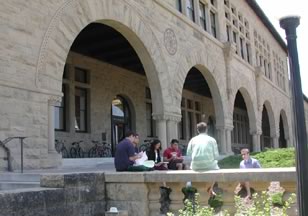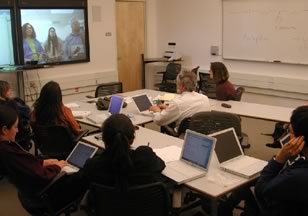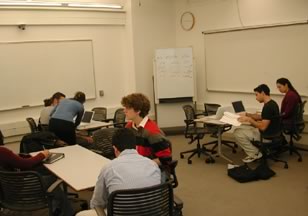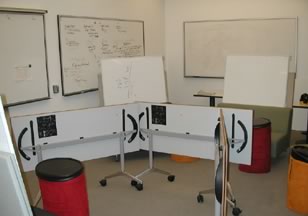Chapter 36. Stanford University: Wallenberg Hall
What Is It?
Wallenberg Hall [http://wallenberg.stanford.edu/] opened in 2002 to showcase Stanford University's commitment to advancing learning. Originally completed in 1900, the interior was completely redeveloped with a generous $15 million grant from the Knut and Alice Wallenberg and Marcus and Marianne Wallenberg Foundations in Sweden. (See Figure 1.)
Figure 1. Student Breakout Group Outside Wallenberg Hall

Five advanced resource classrooms occupy the first floor of Wallenberg Hall: four classrooms that can host up to 25 students and the Peter Wallenberg Learning Theater, which handles classes up to 50 students and small performances. (For details, see [http://wallenberg.stanford.edu/classresources/details.html]). These spaces can be used individually or in combination to support a myriad of learning activities. All the classrooms contain multiple display screens, laptops, wireless networks, flexible furniture, and multiple writing surfaces to support a wide range of learning activities. (For more on classroom technologies, see [http://wallenberg.stanford.edu/classresources/technologies.html]). The first floor also contains unscheduled breakout spaces designed to support small group work with booth seating, whiteboards, and wireless Internet access [http://wallenberg.stanford.edu/classresources/rooms/breakout.html]. The building's third floor hosts 15 centrally scheduled classrooms, each with a ceiling-mounted projector, a DVD/VHS player, and speakers.
Stanford University is located on the San Francisco peninsula midway between San Francisco and San Jose, California, on 8,200 acres. It is a private research institution serving about 6,500 undergraduate and 8,000 graduate students. Nearly all undergraduates and about 60 percent of graduate students live on campus.
What Happens Here?
Wallenberg Hall hosts regular class sessions, meetings, lectures, conferences, student gatherings, expositions, and other special events, along with four research organizations.
Classes: More than 20 departments, from history to environmental engineering to the School of Medicine, have sponsored undergraduate and graduate courses in Wallenberg Hall. Professors and instructors who use Wallenberg Hall commit to teaching their lectures, seminars, project-based classes, and arts classes with at least one pedagogical innovation. In general, the innovations fall into three categories:
- Expanding the social world of the classroom: Videoconferencing [http://wallenberg.stanford.edu/teachresources/examples/videoconf2.html] over high-speed data networks opens up the classroom to outside participants, including students and experts located elsewhere. See Figure 2.
Figure 2. Sharing Field Experience Through Videoconferencing

- Supporting segmented and distributed work: Modularizing key classroom technologies [http://wallenberg.stanford.edu/teachresources/examples/transitions.html], from furniture to computing resources, supports flexible organizing of classroom interactions and attention into small or large groups.
- Enabling complex information retrieval, display, and inscription: A suite of technologies [http://wallenberg.stanford.edu/teachresources/examples/webster.html], including large-scale displays and electronic whiteboards, enables rich and flexible display and capture of information.
Meetings and student gatherings: Throughout the year, Wallenberg Hall hosts events ranging from PhD defenses to research meetings held via videoconference. Planning sessions from university and industry groups also are held in Wallenberg Hall.
Lectures, conferences, expositions, and other special events: Wallenberg Hall hosts the Stanford Center for Innovations in Learning's lecture series Future of Learning [http://scil.stanford.edu/events/index.html]. The series is designed to inform members of the Stanford community and local citizens about developments of critical importance in education today.
Research: Wallenberg Hall is home to four research organizations that have sponsored a broad variety of interactive media research projects such as:
- The Stanford Center for Innovations in Learning (SCIL) [http://scil.stanford.edu/]
- Stanford Humanities Lab [http://shl.stanford.edu/]
- Media X
- Wallenberg Global Learning Network (WGLN) [http://www.wgln.org/]
How Is Technology Used?
The entire facility is supported with wireless high-speed Internet access. In addition to the examples listed above in "What Happens Here," the Wallenberg Hall Web site lists multiple case studies [http://wallenberg.stanford.edu/teachresources/experiences_summary.html] of innovative uses of classroom technologies.
Multiple large-screen displays: Instructors and students use multiple screens to compare and add context to their work (see a case study [http://wallenberg.stanford.edu/teachresources/examples/multimedia.html]).
CopyCams: Teams use CopyCams to capture work done on whiteboards to document their processes as well as to continue work outside class (see a case study [http://wallenberg.stanford.edu/teachresources/examples/copycams.htm]).
Laptops with iSpace collaborative software: Students use experimental software to share Web sites and files from their personal laptops with the entire class. Students also author documents and media in small groups on collaboration stations.
What Makes the Space Successful?
Three characteristics contribute to Wallenberg Hall's success:
- Network convergence
- Changing instructor roles
- Multiple roles for academic technology staff
Convergence of networks on campus, in Silicon Valley, and campuses globally: Wallenberg Hall is in the geographic center of Stanford's campus, and Palo Alto is in the heart of Silicon Valley. This location provides many critical opportunities for interactions among people who ordinarily wouldn't cross paths, resulting in a loose network that supports innovative practice beyond the classroom.
Changing roles of instructors and students: Teaching in Wallenberg Hall forces instructors to think creatively about their pedagogies. In Wallenberg Hall's highly instrumented spaces that support collaboration and interactive technologies, instructors often act as a "guide by the side" instead of a "sage on the stage." (See Figure 3.)
Figure 3. Configuring Furniture for Teamwork

Academic technology staff play multiple roles: The staff that runs the first floor of Wallenberg Hall have a broad skill set to support the design, execution, and evaluation of innovative learning activities. The academic technology specialists (ATSs) who work in Wallenberg Hall and across campus have training in both pedagogical theory and advanced technology. The ATS team helps bridge the gap between faculty's wishes and needs and the technology team's ability to deliver resources.
What Principles Were Behind the Design?
Interactivity, flexibility, collaboration, and acquisition of resources to support reflection contributed to the design of Wallenberg Hall.
Learning first: At every chance, the design team tied learning goals and practices into the design of the spaces themselves. By developing scenarios with instructors that focused on what they and their students would actually do in class, the design team could choose technologies that created new opportunities for instructors.
Flexible spaces to encourage innovation: These learning spaces contain mobile furniture, laptop computers, and portable whiteboards to facilitate multiple learning activities. (See Figure 4.) Additionally, the building has a minimum of load-bearing walls to support future redesigns of the entire floor.
Support for collaborative work practices: Webster digital whiteboards, Huddleboards, flexible furniture, breakout spaces, and experimental software work together to support collaboration in the Wallenberg Hall spaces. The classrooms also include collaboration tools to support remote guest speakers and work practices among distributed teams.
Facilitate capture for archive and reflection: Video cameras and microphones, Webster interactive screens, CopyCams, and easily accessible USB ports are all designed to capture interactions in class for future review by students and instructors.
Figure 4. Folding Tables, Stools, and Mobile Chairs in the Classroom

What Is Unique or Noteworthy?
Wallenberg Hall hosts courses that tie research together with learning. Lessons learned there about prototyping tools and effective practices benefit the rest of campus.
Research into learning: Wallenberg Hall was designed as a loop that connects scholarly research in learning with the practice of instruction. Experiments and prototypes are developed in the fourth floor's research labs, then tested in the first floor's spaces. The best innovations can be put into practice in the general-purpose classrooms on the third floor and throughout campus.
Prototyping tools and practices: Campus groups ranging from residential computing to language centers to research spaces have used the lessons learned from Wallenberg Hall to guide the design of their own spaces. Stanford's Residential Computing, Academic Computing, and other departments have worked with the SCIL team to design other learning spaces on campus that take advantage of the knowledge generated in Wallenberg Hall.
About the Author
Dan Gilbert is an academic technology specialist at Stanford University, working with faculty and instructors to design, carry out, and evaluate learning activities in the experimental spaces of Stanford's Wallenberg Hall.